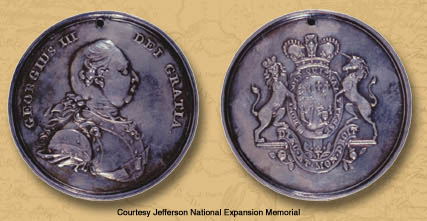On this snowy day at Fort Mandan, Posecopsahe—Black Cat, grand chief of the Mandans—comes to see the American “Curiossities.” He is told to no longer accept peace medals or flags from trader François-Antoine Larocque.
The George III medal features an august image of the American colonists’ nemesis, George William Frederic, of the German house of Hanover, who was king of England, Scotland, Ireland, and the far-flung British Empire, from 1760 until 1814. The obverse (left) of the 76-millimeter disc reads “Georgius III, Dei Gratia”—”George the Third, By the Grace of God.”
Snowy Weather
Snowed hard the Greater part of last night. Snow this morning. the wind from N. E. the River falling. Gealousy between Mr Gisom [Jusseaume] one of our Intr. and George Drewyer last evening &.C.
—John Ordway
Black Cat Visits
the Poss-cop-so-he or Black Cat Grand Chief of the Mandans Came to See us, after Showing Those Chiefs many thing which was Curiossities to them, and Giveing a fiew presents of Curioes Handkerchiefs arm bans & paint with a twist of Tobaco
—William Clark
Larocque’s Peace Medals and Flags
we had Some little talk on the Subject of the British Trader Mr. Le rock [François-Antoine Larocque] Giveing Meadils & Flags, and told those Chiefs to impress it on the minds of their nations that those Simbells were not to be recved by any from them, without they wished incur the displieasure of their Great American Father—
—William Clark
Weather Diary
Ther. at rise
Weather Wind at rise
Thert. at 4 P.M. Weather Wind at 4 P.M. River 12 snow S E 15 snow E fall 4 ft. the Indians left us late in the evening on their return
—Meriwether Lewis[1]To assist the reader, the editor of this web page has omitted the date column, merged the “River” columns, and spelled out some abbreviations.
Fort Mandan is a High Potential Historic Site along the Lewis and Clark National Historic Trail managed by the U.S. National Park Service. The North Dakota Department of Parks and Recreation manages a modern reconstruction and the Lewis and Clark Interpretive Center located at US Hwy 83 and ND Hwy 200A.
Knife River Indian Villages National Historic Site is a High Potential Historic Site along the Lewis and Clark National Historic Trail managed by the U.S. National Park Service. A unit of the National Park System, the site is located at 564 County Road 37, one-half mile north of Stanton, North Dakota. It has exhibits, trails, and a visitor center.
Notes
| ↑1 | To assist the reader, the editor of this web page has omitted the date column, merged the “River” columns, and spelled out some abbreviations. |
|---|
Experience the Lewis and Clark Trail
The Lewis and Clark Trail Experience—our sister site at lewisandclark.travel—connects the world to people and places on the Lewis and Clark Trail.
Discover More
- The Lewis and Clark Expedition: Day by Day by Gary E. Moulton (University of Nebraska Press, 2018). The story in prose, 14 May 1804–23 September 1806.
- The Lewis and Clark Journals: An American Epic of Discovery (abridged) by Gary E. Moulton (University of Nebraska Press, 2003). Selected journal excerpts, 14 May 1804–23 September 1806.
- The Lewis and Clark Journals. by Gary E. Moulton (University of Nebraska Press, 1983–2001). The complete story in 13 volumes.




